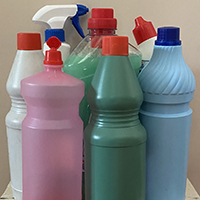Caustic ingestion in children: A 6-year retrospective study

Accepted: 31 May 2020
All claims expressed in this article are solely those of the authors and do not necessarily represent those of their affiliated organizations, or those of the publisher, the editors and the reviewers. Any product that may be evaluated in this article or claim that may be made by its manufacturer is not guaranteed or endorsed by the publisher.
Some aspects of the management of caustic ingestion in children are still debated. We aimed to determine the predictive value of epidemiological and clinical features of caustic ingestion, and to define guidelines adherence. This is a retrospective study on children ≤18 years referred to our Emergency Department over 6 years because of caustic ingestion. Statistical significance at p<0.05. Overall, 107 caustic ingestions were identified, mainly accidental <5 years (87.85%). Bleach was the most common caustic (46.73%). Forty-six patients underwent endoscopy; 57.38% children who should have endoscopy on guidelines, actually did not (p<0.0001), but no complications were reported. No or minimal lesions were reported in asymptomatic children; ≥2 symptoms correlated with the severity of lesions (p<0.0002). Therapy of severe cases was correct; overtreatment was observed for minor injuries (p<0.0001). Asymptomatic children after caustic ingestion have a very low-probability of moderate-severe endoscopic lesions, and the risk of severe damage increases proportionally with ≥2 symptoms. Prospective studies are needed to evaluate the efficacy of intensive clinical observation versus EGD on low-risk children to identify those with clinically relevant esophageal lesions.
Betalli P, Falchetti D, Giuliani S, et al. Caustic Ingestion Italian Study Group. Caustic ingestion in children: is endoscopy always indicated? The results of an Italian multicenter observational study. Gastrointest Endosc 2008;68:434-9. DOI: https://doi.org/10.1016/j.gie.2008.02.016
Hoffman RS, Burns MM, Gosselin S. Ingestion of Caustic Substances. N Engl J Med 2020;382:1739-48. DOI: https://doi.org/10.1056/NEJMra1810769
Betalli P, Rossi A, Bini M, et al. Update on management of caustic and foreign body ingestion in Children. Diagn Ther Endosc 2009;2009:969868.
Karagiozoglou-Lampoudi T, Agakidis CH, Chryssostomidou S, et al. Conservative management of caustic substance ingestion in a pediatric department setting, short-term and long-term outcome. Dis Esophagus 2011;24:86-91. DOI: https://doi.org/10.1111/j.1442-2050.2010.01097.x
Gupta SK, Croffie JM, Fitzgerald JF. Is esophagogastroduodenoscopy necessary in all caustic ingestions?. J Pediatr Gastroenterol Nutr 2001;32:50-3. DOI: https://doi.org/10.1097/00005176-200101000-00015
Riffat F, Cheng A. Pediatric caustic ingestion: 50 consecutive cases and a review of the literature. Dis Esophagus 2009;22:89-94. DOI: https://doi.org/10.1111/j.1442-2050.2008.00867.x
Boskovic A, Stankovic I. Predictability of gastroesophageal caustic injury from clinical findings: is endoscopy mandatory in children? Eur J Gastroenterol Hepatol 2014;26:499-503. DOI: https://doi.org/10.1097/MEG.0000000000000060
Bosnali O, Moralioglu S, Celayir A, Pektas OZ. Is rigid endoscopy necessary with childhood corrosive ingestion? A retrospective comparative analysis of 458 cases. Dis Esophagus 2017;30:1-7.
Temiz A, Oguzkurt P, Ezer SS, et al. Predictability of outcome of caustic ingestion by esophagogastroduodenoscopy in children. World J Gastroenterol 2012;18:1098-103. DOI: https://doi.org/10.3748/wjg.v18.i10.1098
Lamireau T, Rebouissoux L, Denis D, et al. Accidental caustic ingestion in children: is endoscopy always mandatory? J Pediatr Gastroenterol Nutr 2001;33:81-4. DOI: https://doi.org/10.1097/00005176-200107000-00014
Thomson M, Tringali A, Dumonceau JM, et al. Paediatric Gastrointestinal Endoscopy: European Society for Pediatric Gastroenterology Hepatology and Nutrition and European Society of Gastrointestinal Endoscopy Guidelines. J Pediatr Gastroenterol Nutr 2017;64:133-53. DOI: https://doi.org/10.1097/MPG.0000000000001408
Betalli P, Rossi A. Consensus statement sulle urgenze endoscopiche non emorragiche in età pediatrica: Progetto Airone. (Italian) Milan, Italy: AQ Edition; 2008.
Persson H, Sjöberg G, Haines J, et al. Poisoning Severity Score: grading of acute poisoning. J Toxicology 1998;36:205-13. DOI: https://doi.org/10.3109/15563659809028940
Zargar SA. The role of fiberoptic endoscopy in the management of corrosive ingestion and modified endoscopic classification of burns. Gastrointest Endosc 1991;37:165-6. DOI: https://doi.org/10.1016/S0016-5107(91)70678-0
Di Nardo G, Betalli P, Illiceto MP, et al. Caustic ingestion in children: one year experience in three Italian referral centers. J Pediatr Gastroenterol Nutr 2020; ahead of print (doi number: 10.1097/MPG.0000000000002685).
Dogan Y, Erkan T, Cokugras FC, et al. Caustic gastroesophageal lesions in childhood: an analysis of 473 cases. Clin Pediatr (Phila) 2006;45:435-8. DOI: https://doi.org/10.1177/0009922806289618
Alipour Faz A, Arsan F, Peyvandi M, et al. Epidemiologic Features and Outcomes of Caustic Ingestions; a 10-Year Cross-Sectional Study. Emerg (Tehran) 2017;5:e56.
Manes G, Rossi A, Bini M. L’ingestione di sostanze caustiche: guida al management del paziente acuto (Italian). Giorn Ital End Dig 2012;35:23-27.
Contini S, Scarpignato C. Caustic injury of the upper gastrointestinal tract: a comprehensive review. World J Gastroenterol 2013;19:3918-30. DOI: https://doi.org/10.3748/wjg.v19.i25.3918
Sanchez-Ramirez CA, Larrosa-Haro A, Vasquez-Garibay EM, Macias-Rosales R. Socio-demographic factors associated with caustic substance ingestion in children and adolescents. Int J Pediatr Otorhinolaryngol 2012;76:253-6. DOI: https://doi.org/10.1016/j.ijporl.2011.11.015
Marchi A, Chiossi M, Renier S, et al. Peculiar features of childhood poisoning and in the maternal-fetal period. (Italian) Ann Ist Super Sanità 2006;42:318-24.
Chen TY, Ko SF, Chuang JH, et al. Predictors of esophageal stricture in children with unintentional ingestion of caustic agents. Chang Gung Med J 2003;26:233-9.
Ducoudray R, Mariani A, Corte H, et al. The damage pattern to the gastrointestinal tract depends on the nature of the ingested caustic agent. World J Surg 2016;40:1638-44. DOI: https://doi.org/10.1007/s00268-016-3466-5
Arevalo-Silva C, Eliashar R, Wohlgelernter J, et al. Ingestion of caustic substances: a 15-year experience. Laryngoscope 2006;116:1422-6. DOI: https://doi.org/10.1097/01.mlg.0000225376.83670.4d
Kurowski JA, Ka M. Caustic ingestions and foreign bodies ingestions in pediatric patients. Pediatr Clin 2017;64:507-24.
Park KS. Evaluation and management of caustic injuries from ingestion of acid or alkaline substances. Clin Endosc 2014;47:301-7. DOI: https://doi.org/10.5946/ce.2014.47.4.301
Atug O, Dobrucali A, Orlando RC. Critical pH level of lye (NaOH) for esophageal injury. Dig Dis Sci 2009;54:980-7. DOI: https://doi.org/10.1007/s10620-009-0767-7
PAGEPress has chosen to apply the Creative Commons Attribution NonCommercial 4.0 International License (CC BY-NC 4.0) to all manuscripts to be published.


 https://doi.org/10.4081/ecj.2020.9044
https://doi.org/10.4081/ecj.2020.9044







